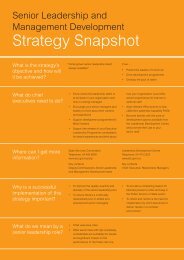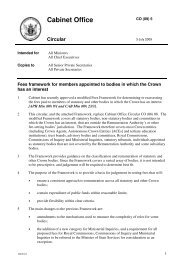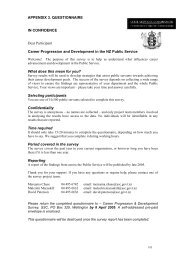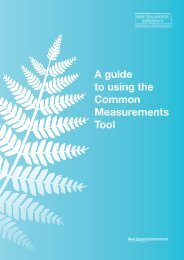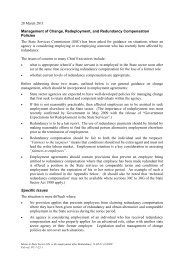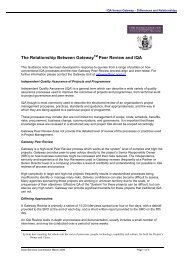NZ Report / Proposal Template - State Services Commission
NZ Report / Proposal Template - State Services Commission
NZ Report / Proposal Template - State Services Commission
Create successful ePaper yourself
Turn your PDF publications into a flip-book with our unique Google optimized e-Paper software.
5 Methodology and Processes: Design, Costing,<br />
Procurement and Scheduling<br />
Key Findings:<br />
• A key feature of the Spring Hill and Otago projects is that they have involved the use of the<br />
Collaborative Working Approach (CWA) methodology. This methodology is relatively new<br />
to New Zealand, although it is used by Transit for some road projects.<br />
• A hybrid form of CWA was used for the Northland project and it was key to overcoming<br />
some issues that were threatening to disrupt progress with that project.<br />
• The collaborative approach implied by the CWA methodology, the advantages offered by<br />
CWA and the positive experience with CWA in the context of Northland led the Department<br />
to use CWA for the other regional prisons, including Spring Hill and Otago.<br />
• The way in which the Department has applied the CWA methodology has enabled it to<br />
benefit from many of the advantages inherent in the CWA approach. In particular:<br />
– there has been close integration of design, construction and commissioning teams<br />
which assists in achieving an optimal balance between design, construction and<br />
operational requirements;<br />
– several value management reviews have been undertaken to further optimise designs<br />
and take out unnecessary costs;<br />
– at a site level, resources have been mobilised to deal with day-to-day issues, thereby<br />
increasing the efficiency of on-site resource utilisation;<br />
– the collaborative approach to dealing with issues has helped to maintain momentum<br />
with the projects, thereby enabling the timing of projects to be completed on, or near<br />
to, expectations;<br />
– high levels of transparency in relation to costs have been achieved at the project level<br />
consistent with the “open-book” philosophy that underpins CWA (with some opportunity<br />
for more transparency over margins – see below); and<br />
– costs have been exposed to extensive third party scrutiny and review.<br />
• Overlaying all of these benefits, the methodology chosen by the Department means that it<br />
is on track to deliver Spring Hill and Otago in time to meet expected prison population<br />
requirements. There were sufficient indications to suggest that, had the Department<br />
elected to follow a traditional procurement method, timeframes for completing the projects<br />
would probably not have been met.<br />
• Notwithstanding these benefits, there are aspects of the way in which methodology and<br />
supporting processes have been applied that can be improved. In particular:<br />
– analysis of the reasons for preferring CWA ahead of other procurement options was<br />
not sufficiently documented;<br />
– the timing for completing the TOC has not conformed with good practice. However, key<br />
reasons behind this were delays in completing designs caused by changes in the<br />
scope of facilities, lack of design resource and shortage of experienced costing<br />
resources. To avoid delays to the projects (and the problems this would cause in<br />
terms of accommodating the increasing prison population), the Department decided to<br />
proceed with the projects; and<br />
– while there is good transparency over costs at the project level, the Department does<br />
not have visibility over margins. As a result, it is dependent on the advice of third<br />
parties.<br />
Methodology and Processes: Design, Costing, Procurement and Scheduling 22




